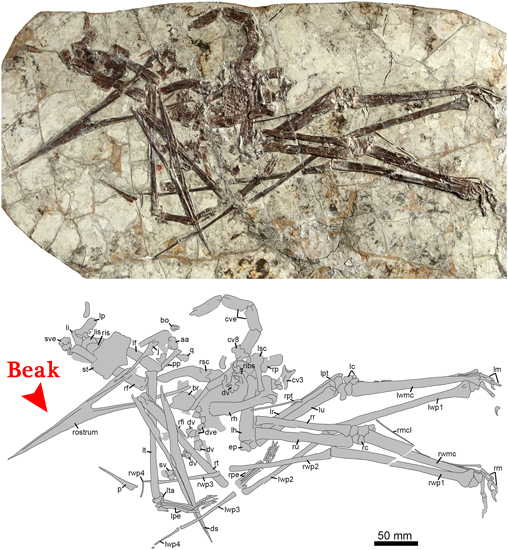Pterosaur Study Sheds New Light on Jidapterus
Jidapterus edentus Gets Grounded
A team of researchers, writing in the on-line, academic, open access journal PLOS One, have published a reassessment of the Early Cretaceous pterosaur Jidapterus (J. edentus). This flying reptile, with a wingspan estimated to be between 1.6 and 1.7 metres, is one of a number of flying reptiles known from the Lower Cretaceous deposits of the Jiufotang and Yixian Formations, which between them have helped palaeontologists to build up a detailed picture about life in northern China some 125 million years ago (Jehol Biota).
In this new study, Jidapterus is identified as a valid genus (there had been some doubts raised over whether or not the single fossil specimen known represented another closely related pterosaur species – Chaoyangopterus zhangi). In addition, the authors postulate that Jidapterus might have been a ground dwelling forager, Everything Dinosaur team members have speculated that Jidapterus only took to the trees to evade predators or perhaps to roost.
The Only Known Specimen of Jidapterus edentus with an Accompanying Line Drawing
Picture credit: PLOS One
Jidapterus – A Tricky Pterosaur
Named in 2003, Jidapterus is known from a single, partially articulated and nearly complete specimen (holotype RCPS-030366CY). It is a member of an enigmatic family of pterosaurs called the Chaoyangopteridae (pronounced Chow-yang-op-tery-rid-aye).
Several species have been named, from Brazil (Lacusovagus) and from Lebanon (Microtuban), to read more about the Lebanese pterosaur, the first flying reptile to be described from this part of the world: Pterosaur Fossil Flies Home. Most of what palaeontologists know, about this family of flying reptiles, distantly related to the giant azhdarchid pterosaurs, comes from studying the fossilised remains of chaoyangopterids from northern China. Trouble is, these delicate flying reptile specimens associated with Liaoning Province are squashed as flat as a pancake. The researchers identified a number of anatomical traits (autapomorphies) that reinforce the idea that Jidapterus should be considered as a distinct genus.
In addition, the scientists examined the feet and claws of Jidapterus and concluded that this flying reptile, once thought to have been a piscivore, was probably omnivorous, foraging on the forest floor for seeds and other plant material, as well as snatching up invertebrates and small creatures. Whether or not the narrow, pointed beak (labelled in the diagram above) was entirely toothless remains open to debate.
The scientific paper: “The Toothless Pterosaur Jidapterus edentus (Pterodactyloidea: Azhdarchoidea) from the Early Cretaceous Jehol Biota and its Paleoecological Implications” by Wen-Hao Wu, Chang-Fu Zhou and Brian Andres published in PLOS One.
Visit the Everything Dinosaur models section for replicas of pterosaurs: Dinosaur, Marine Reptile and Pterosaur Models.


